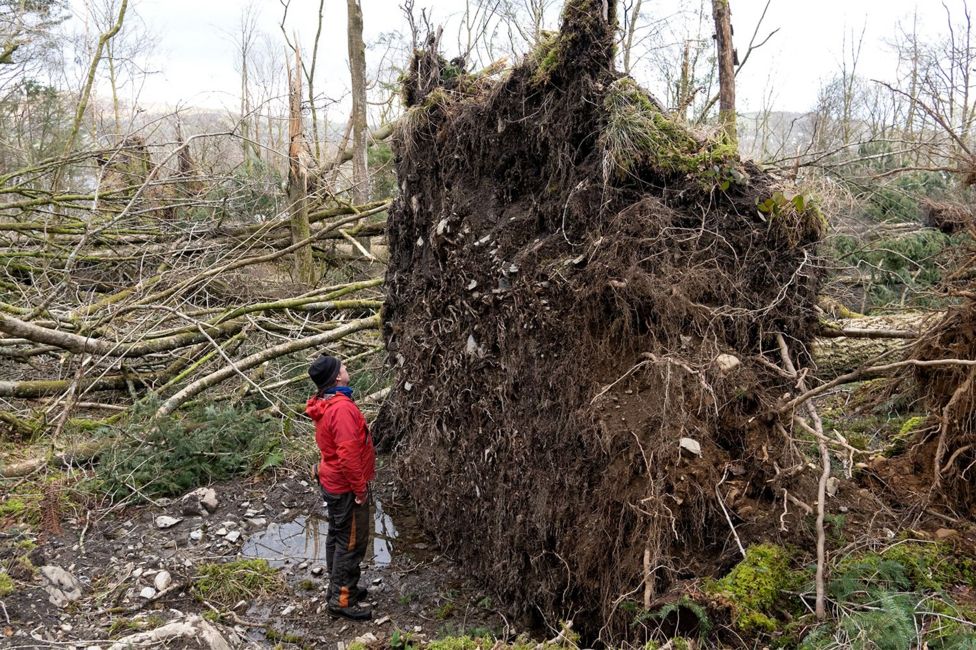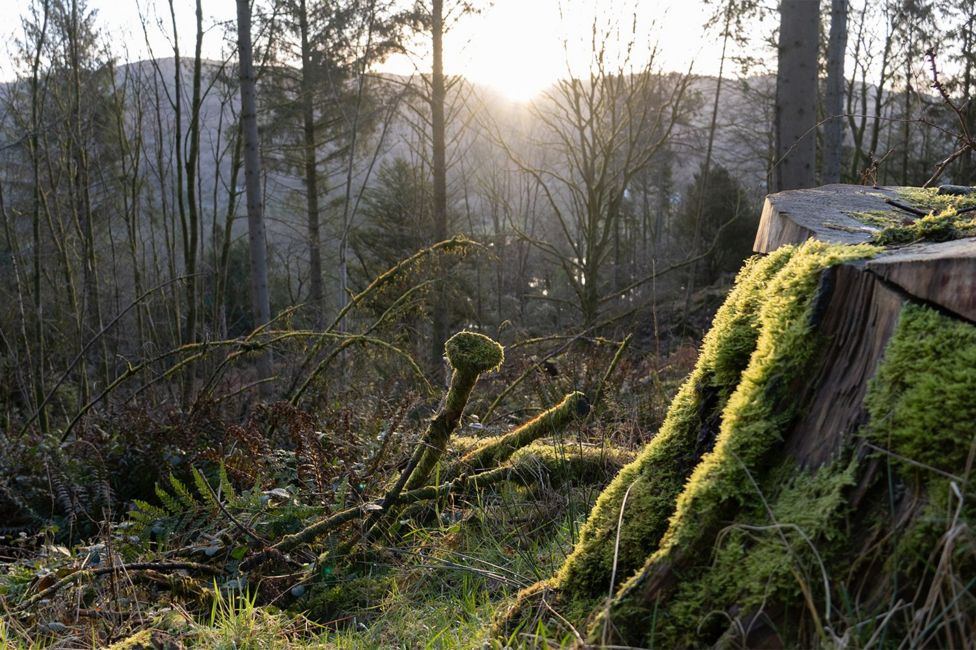MORE THAN EIGHT MILLION TREES LOST IN UK WINTER

BBC : 18 February 2022
It is the untold story of the winter storms. More than eight million trees have been brought down and many are now threatened by another two named storms bearing down on Britain.
Forest managers warn that already “catastrophic” damage will be made worse by Storms Dudley and Eunice.
There are warnings that the heating climate is making our weather more severe and unpredictable, and that management and planting strategies must adapt more quickly.
Forest ranger Richard Tanner says that he’s never seen a real battlefield, but the west shore of Windermere now reminds him of photographs he has seen.
“It looks like someone’s set off a bomb.”
All around are the giant root plates of fallen trees, some the size of caravans, studded with rocks torn from the earth.
“There’s three tonnes of tree and then five or six tonnes of earth maybe. And that’s all got to be dealt with. We’ve lost thousands and thousands of trees just on this one property.”
Mr Tanner has looked after the South Lakes property of the National Trust for a decade, which includes the crested beech at Wray Castle. It was a champion, with the biggest girth in Britain and Ireland. “But Arwen’s 90mph winds were too much.”
We head south to the other end of Windermere, and Great Knott Wood. In November 2021 Storm Arwen knocked down over a third of it in one night, including dozens of ancient oaks and yew trees. It’s still too dangerous to allow the public back in – thousands of trees are weakened and precariously balanced.
“Put it this way, we wouldn’t be here if it was windy,” says Heather Swift. She has cared for this site on behalf of the Woodland Trust for two decades.
“We did have this nice, dappled light and shade, but now all the spring plants that are trying to come up, they’re stuck under this wet, dark blanket of fallen trees.”
Kelvin Archer manages all the Trust’s forests from the Scottish border, down to the Midlands, and across to both coasts.
He says almost a quarter of the charity’s standing woods – hundreds of thousands of trees – have fallen.
“Climate change means that storms normally only seen in north-east Scotland are now hitting Northumberland and right across to Cumbria.”
He says that woods that were “firm and safe” are now getting blown over.
“We are now seeing damage to woods that have been here for generations that can’t handle the new storm issues we are having.”
Many species anchor roots, and woodlands shape themselves in a way to help them withstand our prevailing south-westerly winds. They weren’t prepared for Storm Arwen, which barrelled in from the north.
“I’m a forester because I love woodlands,” says Mr Archer. ” I come out here because it’s a safe space for me. And we’re losing them.”
The storms are savaging Scotland with the greatest force.
After Storm Arwen in November, 4,000 hectares of woodland were blown down – estimated to be eight million trees.
Since then, Malik and Corrie have struck and the damage is now estimated to be 7,000 hectares – the equivalent of around 10,000 football pitches.
Doug Howieson is the head of Operational Delivery for Scottish Forestry. He says the number of storms this winter is “unprecedented”. He warns that the winds have already “punched holes” in the forests, and Storm Dudley, expected to hit tonight, is likely to make them worse.
“It is critical that we plant in the right place and in the right time now, to shape our future forest’s resilience to climate change.”
A new citizen science app has been launched to help people on the ground to report damage.

However, the keepers of the woods do point out that it’s not all bad. Mr Tanner picks at the earth-clogged roots of a fallen tree.
“Look at this gap, it’s ideal for a wren to nest. There is hope for the woods because there is natural regeneration. Over there we’ve got some hazel coming through, a bit of ash.”
Many of the felled trees can be sold for timber – although industry experts do say wind-blown trees are often harder to recover and tend to fetch a lower price. Some deadfall will be allowed to rot, creating new habitat. Different species can be planted in the gaps the fallen trees have left to create more diversity.
Mr Archer says that it’s vital to keep planting trees – even though they can blow down.
“We’ve got to sink carbon, we’ve got to have places for people to enjoy, we need timber and we also need habitats for the wildlife that’s around us. We will tidy this up and try to recover this wood for the next generation. It will take 40 to 50 years before anything is back here, but we are dedicated to doing it.”




